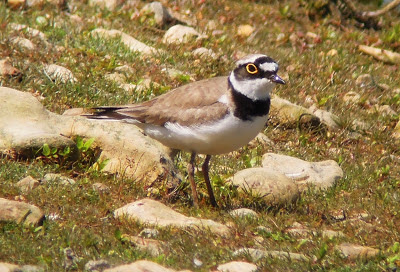Eighty species have bred at Amwell
over those years, 46 of them managing to enter the ‘scoresheet’ for 2012. This is somewhat below the 53 species in the
best year; 2001. These 46 species
amounted to a total of 327 pairs of birds, again somewhat below the peak of 410
pairs in 2002. So the headline story is
somewhat of a rise and fall. However, as
you would expect, these figures hide the many changes over the years. A number of species, such as Willow Warbler, Yellow
Wagtail (5 pairs in 1983), Turtle Dove, Linnet and Tree Sparrow, have all declined
more or less in line with national trends. But without doubt, the major influence has
been successional changes in the habitats, with meadow, marsh and mud being
replaced by reed and willows.
These changes have, of course,
produced a number of winners: Grey Herons and Cormorants in the trees, recently
joined by Little Egrets, and Reed Warblers, Cetti’s Warblers and Blackcaps in
the reed and scrub. In addition,
Black-headed Gulls and Common Terns have used the rafts provided. The losers have been the grassland birds of
the old meadows and more significantly the variety of wildfowl and waders. Tufted Ducks peaked at a massive 62 broods in
1987 but have since dropped away to low single figures. Likewise, Gadwall rose to a peak of 12 broods
before dropping to just one and after peaking at 53 pairs, Sedge Warblers have
dwindled to just 14 as habitats have changed.
Wading birds, particularly the Little
Ringed Plover, have always been a key feature of the site since the mineral
extraction began. LRPs peaked at 8 pairs
but with numbers rising and falling in relation to the amount of habitat. Despite the recent addition of Oystercatcher
in recent years, LRPs and waders in general, are now teetering on the edge of
disappearing as breeding birds. The problem is that the relentless march of
reed and other vegetation across the formerly open areas outpaces the
management effort. What is needed, what
most old gravel pits need, is a bit of Localised Intermittent Catastrophe. A combination of controlled vandalism with a
large digger and some dynamic water management should help knock selected areas
back to an earlier stage in the succession so the process can start again. We gathered on site this autumn, umm-ed and
arr-ed a bit, and some good work was subsequently undertaken, but on
reflection, much more of the same will be required if LRPs are to remain until
the end.
Below - Amwell 1987 (8 prs of LRP), Amwell 2012 (none).



4 comments:
100% agreed Graham. I think we have identified these issues again and again, both at the level of the Lee Valley (and the gradual stabilization of the vegetation, at or approaching climax, just about everywhere that isn't in (very) active agricultural production) and elsewhere throughout Europe.
I'm seeing exactly the same processes here at Isola della Cona in Italy although Carmargue horses are being used to hold the succession at the grassland phase .... it doesn't alter what is happening below the water surface (a gradual decline in productivity as more and more nutrients are locked up in sediments, vegetation and large fish) or the terribly low production of seeds as a result of a virtual absence of annual 'weeds'.
Another thing to note is how difficult it is for species such as Turtle Dove or Tree Sparrow to maintain themselves in pockets of decent habitat in a desert of weed-free agriculture.... the sources of food need to be thinly spread across large swathes of countryside.
How have the corvids fared in the 35 years? Have you considered that, as at Rye Meads, you might be drawing LRPs into sites that are now full of Carrion Crows and overlooked by large trees that were absent or small in the 1980s.
Nice to see that old photo, as my first visits were about that time.
Unfortunately the emphasis on increasing the reed beds throughout the Lea Valley has of course had a detrimental effect on waders and it is no surprise to see the decline of LRPs over that period at Amwell. Short of removing large areas of willow scrub and reeds, and reinstating safe areas of gravel I think they will only end up as passage migrants.
I suspect that the increase in predators in particular the sudden and massive build up in the area of breeding of Black headed Gulls is going to be a major headache as well.
Thanks Paul, interesting comment as usual. Yes, weeds and seeds is another whole issue in the valley -very few flocks of finches etc around these days.
Crows and Magpies have always been around in small numbers without much change. Yes, you have a point about predators, although I've no doubt that foxes are the main problem, both at Rye Meads and Amwell. If the nests manage to escape the attention of the foxes, then the chicks have to avoid the crows and herons.
Hi Phil, hopefully we can remove a bit more reed from in front of the viewpoint! Yes, predators are a major issue. Thanks for your comment.
Post a Comment